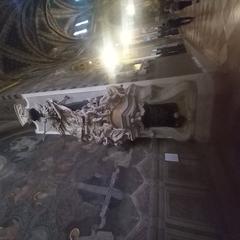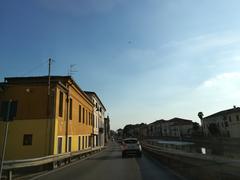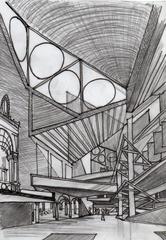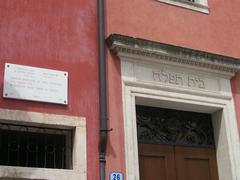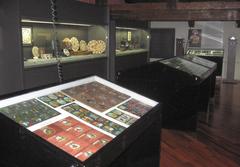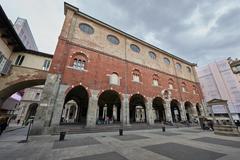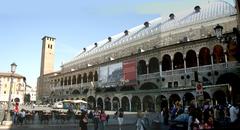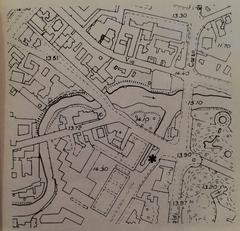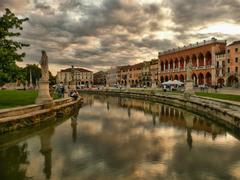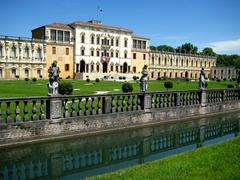Comprehensive Guide to Visiting Porta Altinate, Padua, Italy
Date: 01/08/2024
Introduction
Nestled in the heart of Padua, Italy, Porta Altinate is a historical marvel that offers visitors a captivating journey through time. This ancient gateway, dating back to the 13th century, stands as a testament to Padua’s rich Roman and medieval heritage. Originally part of the city’s defensive walls, Porta Altinate has witnessed numerous historical events, from invasions to significant political changes, making it a cornerstone of Padua’s historical landscape (Turismo Padova). Despite being partially obscured by modern development, the gate’s architectural and cultural significance continues to attract history enthusiasts from around the world. This comprehensive guide aims to provide all the essential information for visitors, including the history, visiting hours, ticket prices, and travel tips to ensure a memorable experience.
Table of Contents
- Introduction
- History of Porta Altinate
- Visitor Information
- Preservation Efforts
- Educational Value
- Community Engagement
- Future Prospects
- FAQs
- Conclusion
History of Porta Altinate
Origins and Construction
Porta Altinate, a significant historical gateway in Padua, Italy, dates back to the 13th century. This ancient gate was part of the city’s first defensive walls, which were crucial for protecting Padua from invasions and conflicts. The gate was reconstructed in 1286, a testament to its enduring importance in the city’s fortifications (Turismo Padova).
Architectural Significance
The architectural design of Porta Altinate reflects the medieval military engineering techniques of the time. The gate’s robust structure was designed to withstand sieges and attacks, featuring thick walls and a strategic location that controlled access to the city. The gate’s design also included a central arch flanked by two smaller arches, a design typical of Roman gates, constructed using large stone blocks. The rise-to-span ratio of the main arch is 1:4, while the lateral arches have a ratio of 1:3.7, providing both structural stability and aesthetic appeal.
Cultural and Historical Importance
Porta Altinate holds immense cultural and historical significance for Padua. It was a crucial point of entry for traders, travelers, and military personnel, making it a bustling hub of activity. Its enduring presence serves as a reminder of Padua’s resilience and historical importance. Today, Porta Altinate attracts tourists and history enthusiasts from around the world, despite being less visible due to modern urbanization.
Visitor Information
Visiting Hours and Tickets
- Visiting Hours: Porta Altinate is accessible at any time, as it is located in a public area. However, guided tours may have specific timings.
- Tickets: There is no entrance fee to visit Porta Altinate. Guided tours might have a nominal charge.
Visitor Tips
- Guided Tours: Consider joining a guided tour to gain in-depth knowledge about Porta Altinate. Local guides provide fascinating insights and anecdotes that enhance the experience.
- Nearby Attractions: Explore other nearby historical sites such as the Ponte Altinate, another Roman bridge located close by.
- Photography: Capture the essence of Padua’s historical charm by photographing the nearby streets and landmarks.
- Local Cuisine: Indulge in some local cuisine at nearby cafes and restaurants. Padua is known for its delicious Italian dishes.
- Accessibility: Porta Altinate is located in a central area of Padua, making it easily accessible by public transport.
Special Events and Tours
- Historical Reenactments: Occasionally, historical reenactments are held around Porta Altinate, offering a unique way to experience the past.
- Educational Tours: Schools and educational institutions often organize field trips to Porta Altinate, providing students with a tangible connection to history.
Preservation Efforts
Preserving Porta Altinate and other historical landmarks in Padua is a priority for local authorities and heritage organizations. Efforts are ongoing to maintain the structural integrity of the gate and promote its historical significance. Informative plaques and markers have been installed to educate visitors about the gate’s history. Archaeological studies and conservation projects are regularly conducted to ensure that Porta Altinate remains a well-preserved historical site.
Educational Value
Porta Altinate serves as an educational resource for students, historians, and researchers interested in Roman history and architecture. The gate provides valuable insights into Roman engineering techniques, urban planning, and the historical context of Padua. Educational institutions often organize field trips and study tours to Porta Altinate, allowing students to engage with history in a tangible way.
Community Engagement
The local community in Padua takes great pride in its historical heritage, and Porta Altinate is a focal point of community engagement. Cultural events, historical reenactments, and public lectures are often organized around the gate to celebrate and promote Padua’s rich history. These events attract tourists and foster a sense of pride and ownership among local residents.
Future Prospects
Looking ahead, there are plans to enhance the visibility and accessibility of Porta Altinate. Proposals include the development of a dedicated visitor center, interactive exhibits, and virtual reality experiences that allow visitors to explore the gate in greater detail. These initiatives aim to make Porta Altinate a more prominent and engaging historical attraction in Padua.
FAQs
- What are the visiting hours for Porta Altinate? Porta Altinate is accessible at any time, as it is located in a public area. Guided tours may have specific timings.
- How much are tickets for Porta Altinate? There is no entrance fee to visit Porta Altinate. Guided tours might have a nominal charge.
- What other historical sites are near Porta Altinate? Nearby historical sites include the Ponte Altinate, another Roman bridge close by.
Conclusion
Porta Altinate is a significant historical landmark that offers a glimpse into Padua’s rich Roman heritage. Its architectural design, cultural importance, and enduring presence make it a must-visit site for anyone interested in history and architecture. By preserving and promoting Porta Altinate, Padua continues to honor its past while providing valuable educational and cultural experiences for visitors and locals alike.
References
- Turismo Padova. Porta Altinate. Retrieved from Turismo Padova
- Xixerone. (n.d.). Must-see attractions in Padua, Italy. Retrieved from xixerone.com
- Travellers Worldwide. (n.d.). Best time to visit Italy. Retrieved from travellersworldwide.com
- Fearlessly Italy. (n.d.). Best time to visit Italy guide. Retrieved from fearlesslyitaly.com

